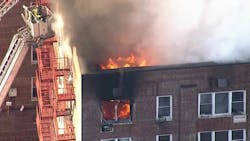As our industry reconnects in some form or another at AHR Expo in Las Vegas, we are all thrilled to have the big show back, albeit altered. Granted, there is still a sizeable cloud over the proceedings again this year, with the Omicron variant of the Coronavirus pandemic still filling hospitals across the U.S.
But the hosts, exhibitors, attendees, ASHRAE Winter Conference presenters and staff all seem determined to make this event as safe and as valuable an experience as possible. After last year’s cancellation of AHR Expo due to COVID-19, so many of us are desperate to see each other face-to-face again that multiple vaccinations, boosters, frequent testing, and N-95 masks now seem like a small price to pay for this long overdue reunion.
That said, overcoming fear of the virus with building ingenuity isn’t the only story dominating our thoughts as we start the new year.
In early January, just four days apart, two horrendous apartment fires in Philadelphia and Bronx, NY, killed a combined 29 people, including 16 children, leaving residents and local officials in both communities reeling and asking questions about how to make sure such tragedies do not happen again. According to the National Fire Protection Association (NFPA), the two fires are among the nation’s 10 deadliest since 1980. The dozen who died in Philadelphia represented that city’s highest death toll from a fire in over a century.
“The horrific residential fires in Philadelphia and the Bronx thrust fire and life safety in the United States into the spotlight,” wrote NFPA President James Pauley, in a January 19 blog. “And while the stories out of these two cities are absolutely heartbreaking, the collective, heightened interest in the protection of people and property that we’ve seen among policymakers and the public may be somewhat encouraging – if it prompts needed changes and more awareness.”
The three-story brick row homes in Philadelphia and 19-story, 120-unit apartment building in the Bronx were both affordable housing complexes for low-income families. Investigators believe the Philadelphia fire was started by a five-year-old child playing with a lighter next to a Christmas tree. According to Associated Press, the building actually had 13 tamper-resistant, 10-year detectors, all of which were operational during the last inspection in May 2021.
In the Bronx, investigators say that a malfunctioning space heater sparked a fire on the second and third floors of the 50-year-old building. The initial blaze was contained, but an open door to a stairwell let smoke spread quickly throughout the building.
“These recent tragedies present a stark contrast to the fire progress that has been documented over the last four decades,” noted Pauley. “(But) home fires have become more deadly as home fire escape times have dramatically decreased – due to a variety of factors. Combustible building materials and synthetic contents in homes burn hotter and faster. The danger of fire is compounded by open floor plans that are prevalent in newer homes and the lack of sufficient fire safety measures in older buildings, large and small.”
Technology, of course, can help. Toward that end, Johnson Controls, in particular, is among firms aiming to raise the profile of building life, safety issues, especially in light of these recent tragedies.
“When building managers are thinking of ways to future-proof their buildings to guarantee ongoing safety for occupants, fire safety systems should be a major factor in their plans,” says Tracy Long, vice president and general manager of fire protection services at Johnson Controls. “All systems, including fire, need to be connected and digitally enabled to provide insights that support safe, sustainable, future-ready buildings.”
Of course, other issues have traditionally gotten in the way.
“The biggest obstacles we see, time and again, when it comes to reducing loss are the issues of over-confidence and complacency,” added Pauley. “The reduction in most fires over the years has led policymakers and citizens alike to erroneously think that fire is no longer a significant issue in our country. There is a prevailing mindset that tragic incidents like the ones that recently occurred happen to other people, in other communities, and in other homes. Until, of course, it happens to them.”
#######
About the Author
Rob McManamy
Editor in Chief
An industry reporter and editor since 1987, McManamy joined HPAC Engineering in September 2017, after three years with BuiltWorlds.com, a Chicago-based media startup focused on tech innovation in the built environment. He has been covering design and construction issues for more than 30 years, having started at Engineering News-Record (ENR) in New York, before becoming its Midwest Bureau Chief in 1990. In 1998, McManamy was named Editor-in-Chief of Design-Build magazine, where he served for four years. He subsequently worked as an editor and freelance writer for Building Design + Construction and Public Works magazines.
A native of Bronx, NY, he is a graduate of both the University of Virginia, and The John Marshall Law School in Chicago.
Contact him at [email protected].
